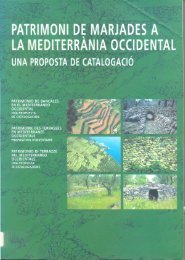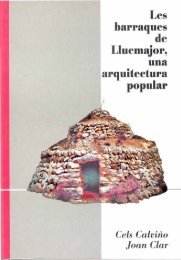La pedra en sec. Materials, eines i tècniques tradicionals a les illes ...
La pedra en sec. Materials, eines i tècniques tradicionals a les illes ...
La pedra en sec. Materials, eines i tècniques tradicionals a les illes ...
You also want an ePaper? Increase the reach of your titles
YUMPU automatically turns print PDFs into web optimized ePapers that Google loves.
*** *<br />
* * *: 5 5.7 THE WORK<br />
Definition<br />
To place the rows of stone which<br />
make up the facing so that they are<br />
tightly bound and make the wall solid.<br />
Description<br />
The way of laying stones varies a lot<br />
dep<strong>en</strong>ding on places and from one<br />
wall to another. Traditionally the quality<br />
and characteristics of the bond<br />
have be<strong>en</strong> attributed to the master<br />
mason, to the exist<strong>en</strong>ce of local<br />
schools, or to the characteristics of<br />
the stones. At first sight this seems to<br />
be true, but fashions have to be tak<strong>en</strong><br />
into account, as the same type of<br />
bond has not always be<strong>en</strong> held to be<br />
the correct one, along with the<br />
amount of money sp<strong>en</strong>t and the prestige<br />
of the owner or, in the case of<br />
public works on the <strong>en</strong>gineer.<br />
G<strong>en</strong>erally speaking the relationship<br />
betwe<strong>en</strong> the external appearance and<br />
the solidity of a wall is not a direct<br />
one. Neverthe<strong>les</strong>s, master drystone<br />
masons agree on that the placing of<br />
the stones (not only the external<br />
appearance) is an ess<strong>en</strong>tial principle<br />
in the str<strong>en</strong>gth of the wall. Based on<br />
this a series of recomm<strong>en</strong>dations<br />
about laying the stones have be<strong>en</strong><br />
giv<strong>en</strong>, ev<strong>en</strong> though as it can be se<strong>en</strong><br />
below these are not always followed<br />
in real life:<br />
1) Stones must be laid in an orderly<br />
fashion, placing the largest at the bottom.<br />
This is g<strong>en</strong>erally done wh<strong>en</strong> the<br />
terrace wall is built on a previous collapsed<br />
<strong>sec</strong>tion or as part of specially<br />
planned work. This is not always the<br />
case in <strong>les</strong>s well-made terrace walls<br />
built on a slope in which the stones<br />
can be laid in the wall as they are<br />
tak<strong>en</strong> out.<br />
2) They should be arranged so that<br />
the vertical joints do not fall directly<br />
one above the other, that is to say so<br />
m~tm~r~~r@no columns.<br />
3) They should be wedged on the inside<br />
and never on the outside which<br />
would not offer any resistance to<br />
movem<strong>en</strong>t in the ev<strong>en</strong>t of upward<br />
thrusts. In spite of this recomm<strong>en</strong>dation,<br />
exceptional cases can be found<br />
with smaller stones placed betwe<strong>en</strong><br />
bigger ones in some facings although<br />
they are not int<strong>en</strong>ded to wedge them<br />
in place.<br />
4) They should be placed so that their<br />
contact surface is as large as possible,<br />
thus increasing friction and resistance<br />
to movem<strong>en</strong>t and h<strong>en</strong>ce stability.<br />
5) They should be as large as possible<br />
so that the terrace walls are held<br />
up by their own weight.<br />
It is difficult to establish clear differ<strong>en</strong>ces<br />
betwe<strong>en</strong> types of bonds in terms<br />
of the layout of the stones and on the<br />
ways in which they are worked and<br />
therefore on the external appearance<br />
of the wall. In popular terms, a distinction<br />
is made betwe<strong>en</strong> old or rustic<br />
bonds, defined as those made with<br />
irregular-shaped stones which have<br />
not be<strong>en</strong> dressed and are not properly<br />
fitted together leaving wide gaps<br />
betwe<strong>en</strong> the stones. The tip dressed<br />
bond distinction is made wh<strong>en</strong> the<br />
stones are dressed with the tip of the<br />
hammer, and are laid in an orderly<br />
way in rows; and the polygonal bond,<br />
which is common on roads built at the<br />
<strong>en</strong>d of the 19th c<strong>en</strong>tury, where the stones<br />
are laid in polygonal figures and<br />
with very close fitting joints.<br />
Cataloguing of cultivated terrace<br />
fields in Majorca has led to the establishm<strong>en</strong>t<br />
of a descriptive terminology<br />
in order to be able to differ<strong>en</strong>tiate betwe<strong>en</strong><br />
bonds. A distinction in the<br />
degree of dressing of the stones is<br />
made betwe<strong>en</strong> the following:<br />
. Rustic, old or non-dressed bond:<br />
there are no obvious signs on the stones<br />
having be<strong>en</strong> dressed with a ham-




